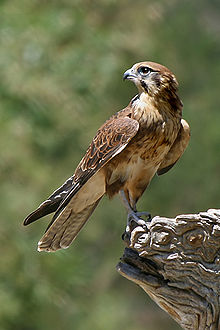
Back Falco Afrikaans Falco AN Fealcen ANG صقر Arabic صقر (جنس طائر جارح من فصيلة الصقريات) ARZ Falco AST Mamani Aymara Qızılquş Azerbaijani Ыласындар Bashkir Siengan BAN
| Falcon Temporal range: Late Miocene to present
| |
|---|---|

| |
| Brown falcon (Falco berigora) in Victoria, Australia | |
| Scientific classification | |
| Domain: | Eukaryota |
| Kingdom: | Animalia |
| Phylum: | Chordata |
| Class: | Aves |
| Order: | Falconiformes |
| Family: | Falconidae |
| Subfamily: | Falconinae |
| Genus: | Falco Linnaeus, 1758 |
| Type species | |
| Falco subbuteo[1] Linnaeus, 1758
| |
| Species | |
|
38; see text. | |
| Synonyms | |
| |
Falcons (/ˈfɒlkən, ˈfɔːl-, ˈfæl-/) are birds of prey in the genus Falco, which includes about 40 species. Falcons are widely distributed on all continents of the world except Antarctica, though closely related raptors did occur there in the Eocene.[7]
Adult falcons have thin, tapered wings, which enable them to fly at high speed and change direction rapidly. Fledgling falcons, in their first year of flying, have longer flight feathers, which make their configuration more like that of a general-purpose bird such as a broad wing. This makes flying easier while learning the exceptional skills required to be effective hunters as adults.
The falcons are the largest genus in the Falconinae subfamily of Falconidae, which itself also includes another subfamily comprising caracaras and a few other species. All these birds kill with their beaks, using a tomial "tooth" on the side of their beaks—unlike the hawks, eagles, and other birds of prey in the Accipitridae, which use their feet.
The largest falcon is the gyrfalcon at up to 65 cm in length. The smallest falcon species is the pygmy falcon, which measures just 20 cm. As with hawks and owls, falcons exhibit sexual dimorphism, with the females typically larger than the males, thus allowing a wider range of prey species.[8]
Some small falcons with long, narrow wings are called "hobbies"[9] and some which hover while hunting are called "kestrels".[9][10]
As is the case with many birds of prey, falcons have exceptional powers of vision; the visual acuity of one species has been measured at 2.6 times that of a normal human.[11] Peregrine falcons have been recorded diving at speeds of 320 km/h (200 mph), making them the fastest-moving creatures on Earth; the fastest recorded dive attained a vertical speed of 390 km/h (240 mph).[12]
- ^ "Falconidae". aviansystematics.org. The Trust for Avian Systematics. Retrieved 25 July 2023.
- ^ Strickland, H.E. (February 1841). "XLVIII. Commentary on Mr. G R. Gray's 'Genera of Birds.' 8vo. London, 1840". The Annals and Magazine of Natural History [series 1]. 6 (39): 416. Retrieved 8 February 2024 – via HathiTrust.
- ^ "Hieracidea Strickland, 1841". WoRMS - World Register of Marine Species. 26 April 2021. Archived from the original on 2 January 2022. Retrieved 8 February 2024.
- ^ "FALNOV.pdf" (PDF). New Zealand Birds Online (published 3 September 2020). 6 March 2013. Archived (PDF) from the original on 8 February 2024. Retrieved 8 February 2024. (Text extracted from Gill, B.J.; Bell, B.D.; Chambers, G.K.; Medway, D.G.; Palma, R.L.; Scofield, R.P.; Tennyson, A.J.D.; Worthy, T.H. (2010). Checklist of the birds of New Zealand, Norfolk and Macquarie Islands, and the Ross Dependency, Antarctica (4th ed.). Wellington, Te Papa Press and Ornithological Society of New Zealand. pp. 174–176.)
- ^ Friedmann, Herbert (1950). The birds of North and Middle America: a descriptive catalog of the higher groups, genera, species, and subspecies of birds known to occur in North America, ... Smithsonian Institution United States National Museum Bulletin, no. 50, part 11. United States Government Printing Office. p. 615. Retrieved 9 February 2024 – via HathiTrust.
- ^ Richmond, Charles W. (1902). List of generic terms proposed for birds during the years 1890 to 1900, inclusive, to which are added names omitted by Waterhouse in his "Index generum avium," ... Proceedings of the United States National Museum. Vol. 24. Washington: Smithsonian Institution / Government Printing Office. p. 685. Retrieved 9 February 2024 – via HathiTrust.
- ^ Cenizo, Marcos; Noriega, Jorge I.; Reguero, Marcelo A. (2016). "A stem falconid bird from the Lower Eocene of Antarctica and the early southern radiation of the falcons". Journal of Ornithology. 157 (3): 885. doi:10.1007/s10336-015-1316-0. hdl:11336/54190. S2CID 15517037.
- ^ Krüger, Oliver (2005). "The Evolution of Reversed Sexual Dimorphism in Hawks, Falcons and Owls: a comparative study". Evolutionary Ecology. 19 (5): 467–486. doi:10.1007/s10682-005-0293-9. S2CID 22181702.
- ^ a b Oberprieler, Ulrich; Cillié, Burger (2009). The raptor guide of Southern Africa. Game Parks Publishing. ISBN 9780620432238.
- ^ Sale, Richard (28 July 2016). Falcons (Collins New Naturalist Library, Book 132). HarperCollins UK. ISBN 9780007511433.
- ^ Cite error: The named reference
j1was invoked but never defined (see the help page). - ^ "The Speed of Animals" in The New Book of Knowledge. Grolier Academic Reference. 2003. p. 278. ISBN 071720538X
© MMXXIII Rich X Search. We shall prevail. All rights reserved. Rich X Search